Sicilian people: mule soldiers, proof of virginity and more.
The elderly Sicilians tell us about the habits of the past. In this episode Vendors of broom, mule soldiers, "nonno sa benerica",…
ETNA
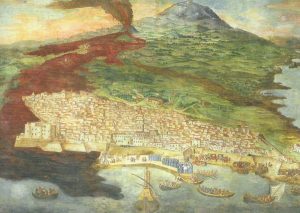
Location: Eastern Sicily
Time for visit: various paths
Level: various
GPS: 37°45’2.90″N – 14°59’44.45″E
With its 3300 meters high, Etna is the highest volcano in Europe.
It is located in eastern Sicily, in the province of Catania.
Its presence starts from the sea, like these stacks in Acitrezza, and goes up, up, up.
At 1000 meters of altitude there are the last small villages.
Gradually the woods and the lava flows of the past increase.
At 2000 meters everything ends: the road and the vegetation.
This is one of the two roads that reach 2000 meters.
From here on it is just a lava desert.
Here you can take a cable car that takes you up to 3000 meters of altitude.
The last 300 meters to reach the top you have to walk.
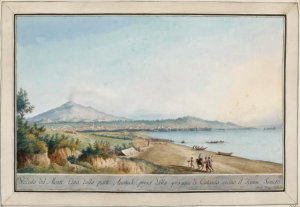
At the top there are 4 craters, sometimes a lot of sulfur, and an extraordinary view.
Etna, a muntagna, as the inhabitants of catania call it, Mongibello, that is, twice a mountain, from mons and gebel, as the Arabs called it, has been a destination for visitors since ancient times: from Empedocles, to the Roman emperors to the great travelers of the Grand Tour to the tourists of today.
It’s huge, gigantic, imposing.
It looks like one of those Buddhas sitting at the entrance of Buddhist temples.
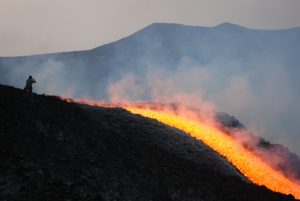
Etna is an active volcano and often launches flames and fire into the sky, for the admiration of those who witness this spectacle but for the desperation of the Etnean women who, armed with broom and dustpan, sweep the lava ash falling from the sky.
Nothing to fear: the top of the volcano is too far from the inhabited centers even if sometimes … the lava does not stop.
As in 1928 when it arrived up to Mascali two steps away from the sea.
From this crater, Montirossi, in 1669 started a flow that reached the sea of Catania.
And this castle, once inside the sea, is now inside the city, since the sea was covered by the lava flow.
This is a house submerged by a lava flow.
There are over 300 craters all around Etna, the so called children of Etna.
Today they are vineyards or places to walk.
There are also more than 300 caves formed by lava: in the past ice was stored there and then sold in the cities.
Besides these ice vendors, other trades have developed thanks to Etna: the charcoal burner, the vendor of broom wood excellent for bakers just to mention two of them.
Etna’s lava is extremely fertile and produces fruits with a particular taste as well as excellent wines.
There are many woods in Etna rich in beeches, oaks, pines, chestnuts.
This one, called the Hundred-Horse Chestnut, is the biggest chestnut in the world.
Everything is black here, everything is lava stone: the walls of the houses, the streets, the baroque, the beautiful Via Etnea and the liotru, the elephant symbol of Catania.
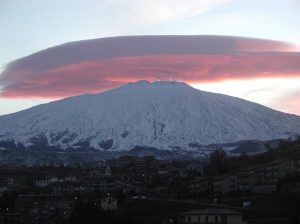
On Etna lived Polyphemus who imprisoned Ulysses and his companions.
Inside the Etna Hephaestus, the god of fire, had the workshop and with his Cyclops helpers molded the metal to make the Trident for Poseidon, the belt of Aphrodite, the phenomenal shield of Zeus and other extraordinary works.
This is called “palmento” and here inside they used to make wine.
From that staircase were thrown the bunches of grapes, just inside that window that gave onto a floor where with the feet were crushed the grapes whose juice would slowly become wine.
Today palmenti are the living rooms of beautiful houses.
This is the wild cat, the most important inhabitant of Etna, along with many small mammals and birds of prey.
This is the castle of Aci Castello, a marvel fused with lava rock.
This is the baroque of Catania where the lava stone is mixed with limestone.
This is a Cuba of Byzantine origin: lava stone and brick.
This is the river Alcantara that has struggled for millennia against the hard lava rock, until it eroded forming beautiful gorges.
Here we are in Giardini Naxos and right here, in the eighth century BC, the Greeks landed and founded their first colony: Naxos, built entirely with lava stone.
This is the Valle del Bove, a gigantic valley that wounds the eastern part of the volcano.
When a new eruption starts, if it is very copious, they try to direct it into this valley, which is a large container and prevents the lava from running quickly to who knows where.
This is the pistachio of Bronte, green gold of Sicily, whose aroma and flavor is unique in the world, thanks to the ash of Etna.
And these are some friends of Splendid Sicily who were lucky enough to have lunch right on top of the volcano.
Etna, a muntagna, colossus of Sicily.
Etna, a muntagna, pride of Sicily.
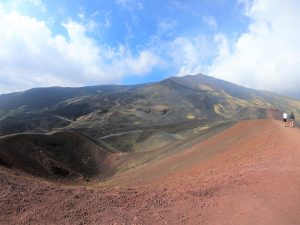
Join our Cultural Department: become a (Splendid) member of Sicily
You have a unique opportunity to support la bella Sicilia.
Contribute to the building of the greatest Cultural Museum of Sicily: you will be ETERNALLY thanked in our video productions and in the related pages.